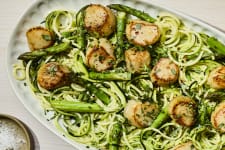
5 Reasons to Choose Wild-Caught Salmon From Alaska
December 14th, 2017Why Is Salmon Good for You?
Many of us are trying to eat less red meat and poultry. In place of these land-based proteins, seafood is often a great alternative. If you’re looking for a well-rounded protein option that you can enjoy on a regular basis, consider wild-caught Alaskan salmon.
From delicate coho to bold sockeye, each species of salmon offers exceptional taste, versatility, and nutrition. When harvested responsibly from Alaskan fisheries, it’s also some of the most sustainable seafood on the planet.
Here are 5 reasons why Alaskan salmon is one of the best sources of protein.
1. It’s Nutrient-Dense
Salmon packs essential nutrients and antioxidants into every bite. And unlike farmed salmon, wild salmon offers high protein while maintaining low levels of saturated fat.1 Notably, salmon contains healthy omega-3 fatty acids, like EPA and DHA. These fats are unique to seafood, and they may help reduce chronic inflammation and support healthy brain function.2 Recent studies have started to explore salmon oil's anti-inflammatory potential on ulcerative colitis.3 This new research signals the healing potential of nutrients in seafood.
Many people are aware of salmon’s omega-3 content. But salmon also contains a powerful blend of vitamins D and B, potassium, selenium, and magnesium. These important nutrients support immune health and bone function.
2. It’s All-Natural
Unlike meat that comes from industrial feedlots, wild Alaskan salmon is always free of antibiotics and hormones. Better still, wild salmon is never genetically modified. Also, don’t worry if you don’t see the word “organic” on your wild Alaskan salmon. There are no human inputs like feed, antibiotics, or other chemicals, so there’s nothing to label or regulate as “organic.”
In contrast, farmed salmon contains synthetic additives that include antibiotics and food pellets engineered with dye. Learn more about the health profile of wild vs. farmed salmon.
3. It’s All-American
Wild Alaskan Company sources wild-caught seafood that’s always harvested and processed in the U.S. This is notable because not all Alaskan seafood is processed domestically — sometimes it is sent abroad. Wild Alaskan Company only offers wild-caught fish and shellfish that has been processed in America to ensure that it is processed in a well-regulated environment.
4. It’s a Sustainable Seafood Option
Wild Alaskan salmon is a great choice for consumers, but it also is a great choice for the environment. Responsibly harvesting salmon in its natural, native habitat helps maintain a sustainable balance in the ecosystem. In contrast, the production of farmed salmon often requires large inputs of antibiotics, pesticides, and other chemicals that pose a threat to other species and critical ecosystems.
Fisheries in Alaska adhere to strict sustainable fishing practices. In fact, sustainable harvest is part of Alaska's state constitution. Science-based management protects salmon stocks and other marine species. By choosing wild salmon, you support responsible fishing practices. In turn, responsible fishing ensures healthy salmon populations for the future.
5. It’s a Versatile Protein
Salmon can be enjoyed using a wide range of cooking methods, flavors, and culinary traditions. Try grilling it with lemon and herbs for a refreshing summer meal. Or, bake it with a maple and garlic glaze for a sweet and savory twist. You can also simply pan-sear a fillet with a sprinkle of salt and pepper for a quick and satisfying dish that’s big on flavor, low in calories, and easy to make.
For more inspiration, check out the best ways to prepare salmon with these five salmon recipes.
Buying Wild Salmon Is Easier Than You Think
The easiest way to enjoy salmon as part of your diet is to connect with a trusted supplier like Wild Alaskan Company. With convenient online ordering and reliable delivery, enjoying genuine wild salmon has never been more accessible. Get sustainably sourced, Alaskan salmon delivered right to your doorstep.





